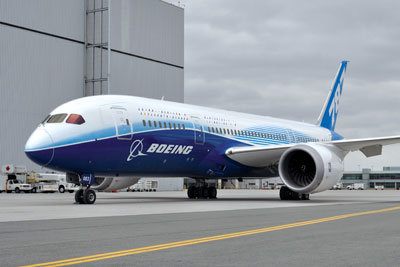
Features
Operations
Alternate Approach: Finding a break in the clouds
As the Boeing 787 Dreamliner sat grounded for a fourth week, the U.S. Federal Aviation Administration (FAA) approved the aircraft for test flights. Still, it wasn’t all good news.
March 6, 2013 By David Carr
As the Boeing 787 Dreamliner sat grounded for a fourth week, the U.S. Federal Aviation Administration (FAA) approved the aircraft for test flights. Still, it wasn’t all good news. Regulators in the U.S. and Japan continued to comb over the airplane looking for whatever it was they might have missed the first time. That same week, the National Transportation Safety Board signalled that a report into the lithium-ion battery was weeks away. Deborah Hersman, NSTB head, has called for regulators to go back to the beginning and review the certification process for the lithium-ion battery onboard the airliner.
 |
|
| “Airplanes don’t make money when rubber stands idle on concrete, so there is a hefty price to be paid.” PHOTO: Boeing
|
Airbus has switched to nickel-cadium batteries for the 350, although lithium-ion technology will be used in early flight testing scheduled to begin later this year.
Airplanes don’t make money when rubber stands idle on concrete, so there is a hefty price to be paid for the thousands of flights cancelled. Launch customer All Nippon Airways (ANA), which has 17 787s in its fleet, calculates it lost $15 million in January alone and is pressing Boeing to accelerate delivery of three Boeing 777s as the airline contemplates a summer schedule without the newest addition to its fleet. Requests for compensation will come later. Other carriers are also plugging gaps with airplanes on routes the 787 was to replace.
The 787 is a magnificent airplane that has landed in with some unfortunate company. The British de Havilland Comet – the world’s first passenger jet – and McDonnell Douglas DC10, were grounded in the early 1950s and late 1970s respectively, following a series of tragic crashes. Both aircraft returned to service (the Comet after a prolonged six-year absence), but neither recovered from the setback. A similar fate does not await the 787.
Boeing has the confidence of its customers. That confidence (along with Boeing’s share price) is proving to be resilient, even as the market wrestles with the grounding possibly stretching into 2014.
As was also experienced with the Airbus A380, every new airplane experiences teething troubles as it enters service (as opposed to fatal design flaws in the case of the Comet and DC10). The 787 was no exception, although issues surrounding the lithium-ion battery overshadow other glitches such as cracks along the cockpit windshield. The 787’s troubles are more deeply rooted and the remedies more severe because the design is so revolutionary. Boeing has many quality program partners around the world, but the aircraft manufacturer is clearly paying a steep price for listening to its bean counters and outsourcing too much of the airplane’s development, resulting in a global jigsaw of blueprints, components that did not fit and massive production delays.
In contrast with the early development of the airplane, Boeing has been able to keep tighter control of the current situation.
Public pronouncements have been few outside the rudimentary confidence in lithium-ion technology and that accelerated production will get the delivery schedule back on track (although that is unlikely for new customers such as Qantas and British Airways, who are expecting deliveries of aircraft this summer. Air Canada’s first 787s are not scheduled to arrive until 2014). Behind the scenes, Boeing is working the telephones daily to keep customers in the loop.
Forbes Magazine recently reported that, “Boeing has an airplane problem, not a PR problem.” Actually, it has both, meaning that solving the problem is only half the solution. Boeing builds the airplanes, but it is customers, like Air Canada, who have to fill them. As the 787 returns to service, the airframer is going to have to repay the loyalty of its customers by stepping up its own public relations game. Watch for Boeing to launch an aggressive media campaign, including social media, promoting the 787 as the marvel it is.
So far, the 787 order book is holding firm and social media has not exploded with travellers refusing to fly the airplane. That may change as the investigation is prolonged and the vacuum is filled with speculation (the chair of the U.S. Senate Commerce, Science and Transportation Committee is calling for public hearings on the safety of the lithium-ion battery). When it does conclude, the investigation will benefit the development of other next-generation airliners such as the Bombardier C-Series and rival Airbus A350. But will customers be as keen to board a 787 when the airplane returns as they were when it first entered service?
Pockets of hesitation not withstanding, the answer is ‘yes.’ Everyone has confidence in Boeing.
David Carr is a Wings writer and columnist.